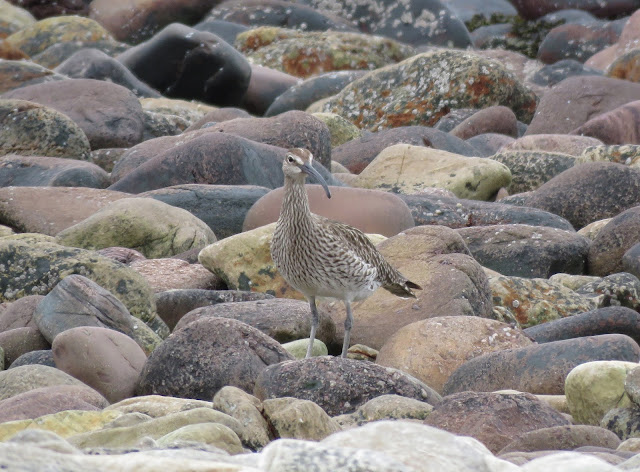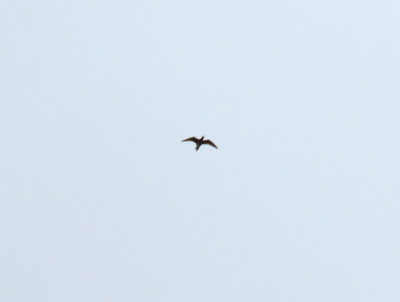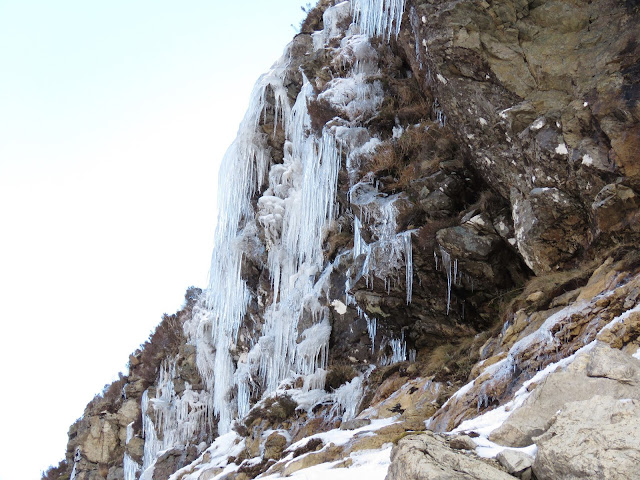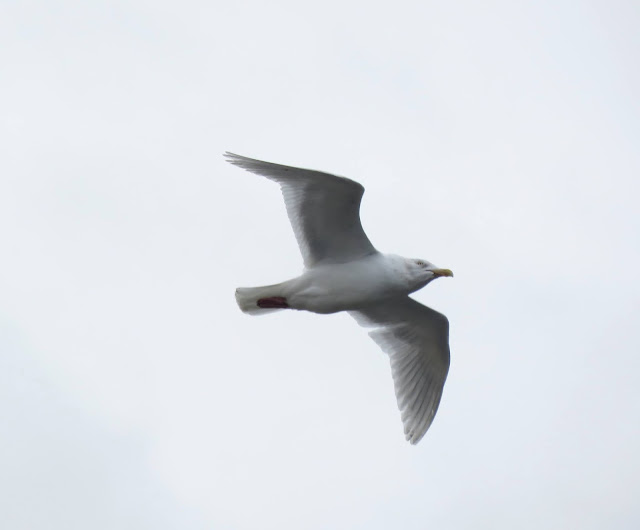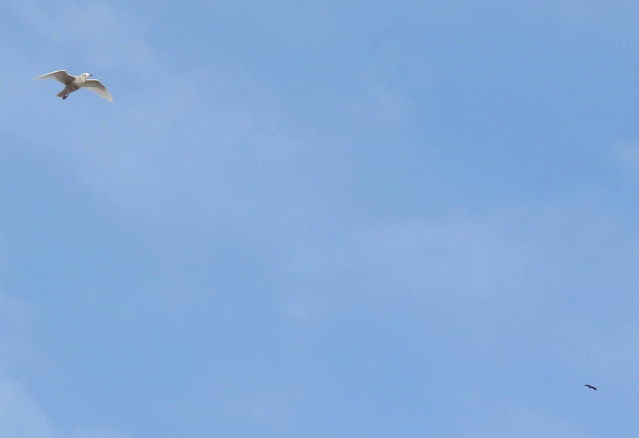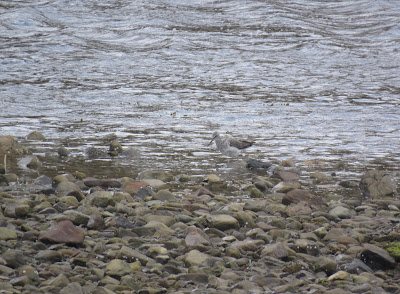Wednesday, April 28, 2021
A redpoll on the feeder was a first for the year.
Several wheatears were seen along the beach, and loads of sand martins dipped and soared over the waves. A large fish jumped out of the water at one point; was it being chased or was it, too, flycatching? A cuckoo was heard from Morefield ( heard yesterday also), but I was too tired to retrace my steps.
Saturday, April 24, 2021
Beinn Liath Mhor a' Ghiubhais Li
We've been up this hill on four previous occasions. Three times it was a there-and-back walk through the plantation, and once a round walk with a descent over Meall Daimh. I've always thought it would be nice to carry on from the top, following the gently-dipping ridge to the south-east - and today we planned to do just that. However, a strong easterly wind was forecast so to avoid both this and the unpleasantness of walking into the sun on such a bright day, we started at the other end. Greger parked his car at the bridge (Fannichs car park already full) and we drove on in mine to the wind-farm road.
Wheatears and meadow pipits flitting about close to the steep gravel road were expected, but we were surprised when two ringed plovers were flushed from a small pool; they scuttled away but didn't fly - a new bird for my Scottish hill-walking list.
We didn't know what it would be like underfoot on the moorland but at least the road gave us a good dry start, probably up to the 400m contour. The turbines were turning and provided eerie company - but we quite liked them. Behind them, Meall Mhic Iomhair looks enticing, with its col linking to an unnamed top - but we're going to follow the road round to the right, to gain the ridge further north.

The moorland was actually relatively dry and, without too much plant growth yet, the going was good. A golden eagle appeared in the sky ahead, flying swiftly along the ridge to our left and being helped on its way by a territorial raven.
A pool containing several dead frogs kept me occupied for a while; they appeared to be encased in jelly.
Happily, a wheatear spotted soon afterwards was very much alive.
Soon we headed up the slope to our right and gained the ridge, where we found the kind of terrain I'd hoped for. The walking here was splendid.
We kept scanning ahead, hoping for ptarmigan or even dotterel running across the stony ground - but there was nothing. However, just to be walking along this broad ridge with stupendous views in all directions, was a tonic. A red grouse was flushed and went winging rapidly over the grass and heather with a soft cluck of protest. Now and then a gust of icy wind would hit us from behind, but on the whole it was less windy than expected, and in any case we found a sheltered spot to have lunch overlooking Loch Glascarnoch.
After lunch we dropped down to a spacious col before the last climb up the Corbett.
From the cairn at the eastern end of the plateau we looked ahead to the summit. Earlier, we'd spotted a couple of walkers there; but they were long gone, and we saw no-one else.
We dropped down from the summit, picking our way carefully among moss-covered boulders; and there, roughly between the 600m and 550m contours, were two ptarmigan.
After a steep, wet, grassy stretch, it was a relief to reach the track; and then it was just a case of plodding down to the main road. Willow warblers and chaffinches were seen/heard in the plantation, and sand martins were swooping over the river just beyond the gate. A good walk.
Thursday, April 22, 2021
There were three species of diver in Achnahaird Bay, although only a winter-plumaged great northern ventured close enough for a photo.
Eventually the sight of a large truck looming up in my back windscreen made me drop the camera on the passenger seat and make a hasty exit! The trouble was, the noise and size of the lorry flushed the birds and they flew off across the headland. Eating my lunch over there a bit later, I spotted a single whimbrel foraging among the stones.
I suspect not. Never mind. Back at the junction, my first lesser black-backed gull of the year was in the rams' field. It looked slightly stunned, as if wondering what it was doing there.
Tuesday, April 20, 2021
Well, today was the best day's birding I've had for a long time - pity my pics don't reflect that. Never mind. Greger stayed at home to brush up on his Spanish (his course starts again next week) and to be there for the heating engineer. Good stuff started on the main road, just before I turned off to Achnahaird, with two pairs of tufted duck on Loch Cul Dromannan.
Not a special bird back in Bucks, but they're quite scarce hereabouts so worth the stop. From the far side of the road came a fluty "Cuckoo!" followed by several more; but try as I might I couldn't see the bird. Several willow warblers were singing, and I saw one but couldn't get a pic - too many twigs in the way. A rapid series of calls made me look up to see a wader flying over, high but not fast. Judging by the length of the bill and the legs, I'd put this down as a greenshank.
Driving along the single-track road, I heard willow warbler song in several places. Walking across the salt-marsh, I heard the calls of golden plover and 33 birds flew over and around, a handful of them landing a bit too far away for photos. A largish flock of ringed plover (probably migrants) held my first dunlin of the year.
Finishing our lunch with cake and coffee, I spotted the tern fishing again. Greger decided to go home, so I walked back out to try and get a closer look. This was the car park as I walked away - just our two cars.
It won't look like this once the tourist season begins! Anyway, back at the beach, I found the tern down on the sand again at the edge of the waves.
Driving out again, I stopped to have a look at a moorland pool - and saw what was probably the budding stems of one of my favourite wildflowers - the bogbean.
Friday, April 16, 2021
Freedom! We can go where we like in Scotland from today, so we celebrated with a trip to Achnahaird (we really know how to push the boat out) and walked across the salt-marsh with the fluty calls of golden plover carrying to us on the wind. They were wary, and after a couple of fly-bys, landed some distance away.
A soft but goose-like "cack" call made us look up - to see a red-throated diver doing circuits above the bay; while small birds were represented by skylarks, meadow pipits, a handful of wheatears, and a stonechat. Greger pointed out a buzzard in the dunes, loitering by rabbit holes in the hope of catching a meal. A snipe species was flushed from the ditch right at the start of our walk; it seemed to make no sound as it rose, flying low in a direct line for a very short distance before dropping into longer grass. I was just beginning to wonder if it was therefore a Jack snipe when the familiar "chipper" call was heard. A common snipe after all, then. On the other side of the headland were a great skua, a redshank, and a gannet.
Tuesday, April 13, 2021
Yesterday: We walked the geology trail at Knockan for the exercise. The steep path was slippery where the sun had not yet reached, with snow and sometimes ice coating the rock steps; and at one point it led directly below clusters of icicles hanging from the crags.
Some had broken off and were lying on the path, and we hurried to get to the end, not relishing the thought of being hit by others. I thought I heard a quiet "chack" from somewhere above, and a thrush-sized bird went flying strongly along the cliff and out of sight. Could be a ring ouzel, but more likely to be a fieldfare.
I climbed joyfully, my painful hips from the previous day forgotten. I felt great. Coming down at the other end, we looked down on four whooper swans in a bay of the loch.
Once down (and after coffee and cake, of course) we walked a short way over the moorland opposite - and several cracking sounds from across the road alerted us to icicles breaking off and falling above the trail. The sun was rising high enough to shine on the edge of the cliffs, making the icicles watery and unstable.
Today: Greger kindly took my car to Inverness to get a new battery fitted, after he'd started it with jump leads from his Toyota. Later, I went for the usual village walk and saw my first common sandpiper of the year foraging quietly in the Ullapool river.
The sighting was compensation for my hips hurting once again; I had to sit down twice during the walk - and yet I was bounding up the cliffs yesterday like a spring chicken. I seem to have become an elderly person, and I don't like it.
Sunday, April 11, 2021
We woke up to a white world once again and set off for our walk in falling snow. We couldn't see the snow buntings on the camp-site, although starlings, redwings, and skylarks were still present. On the river were three greenshanks, chasing each other, calling, and mating.
Saturday, April 10, 2021
We walked a little way up the wind-farm road in swirling snow.
Half an hour later we were down at Silverbridge in bright sunshine, following the forest trail along the Black Water River - where we heard crossbills and saw a pair of grey wagtails and a dipper.
Thursday, April 08, 2021
It would be nice to think that this white-winger was a true glaucous as I haven't seen one for ages, and the bill did look bigger, longer than the viking's; but maybe certain dark pigments in what I presume should be pure white feathers betray its origins. Don't know. It's certainly sulky-looking enough for the viking.
The gulls all went up into the air at one point and became quite hysterical; but as they often do, I didn't take a lot of notice and so almost missed the adult white-tailed sea eagle as it cruised over.
The eagle turned and came back, but more over the village this time than the loch. Still watching the gulls, I thought I spotted the 1st winter Iceland gull, and took a cockeyed picture; it was only when I came to upload the photos that I noticed the eagle in the frame, returning to the harbour once more.
When we saw the snow bunting on the camp-site a couple of days ago, in between first spotting it and then re-finding it, I thought it had the summer plumage of a male bird - basically black and white. But I'd only seen the head and neck above the grass, and then when we got onto the one I snapped and failed to see a second bird, I assumed I'd been mistaken. But later on I learnt that other observers had recorded two snow buntings - so I carried on towards the windy point (two wheatears still present) to investigate.
It was insane on the camp-site - a warmer wind than of late, from the west instead of the north - but it was very strong, coming straight across the loch and the camp-site, making it difficult to use bins and camera. I carefully edged up onto the higher level, and saw a flock of birds on the far side. Something put them up, but while the skylarks went off to one side, the snow buntings flew towards me, landing in the grass on the edge of the nearest path. I sat on the low wooden fence (which is probably against the rules) and tried hard to keep the camera from shaking.
Wednesday, April 07, 2021
Birds are on the move. There was snow on the hills and the moorland down to road level today and it was bitingly cold, but spring can't be far behind. Near the dam we flushed a snipe species from the ditch; it flew over the fence and up the hill with a startled call and was followed by a second (silent) bird. No idea which snipe, but it was a nice encounter.
Across the loch, on the road to the wind-farm, I could see two black birds strutting about. I thought they were probably corvids but reckoned they might just be black grouse, and clicked off a few shots - to the amusement of Greger, who thought I was being way too optimistic. It's true the birds were almost a kilometre away, but when I uploaded the pictures we could see that I'd recorded at least five black grouse, spread across the road and verges like a gang of hooligans.
We drove to the wind-farm road to have our coffee and cake, and soon caught a glimpse of one male grouse flying high towards the loch.
Tuesday, April 06, 2021
We woke up to an inch of snow, and after a blizzard of hail we decided to risk a walk. At the end of West Shore Street were two wheatears (first for the year) - though I managed to snap only one.
Monday, April 05, 2021
It's been a madhouse here with gale-force winds all night and most of today, and a mixture of rain, sleet, hail, and snow - much of the time horizontal. I suffered one shower of hail down by the loch, which gradually turned to sleet. The1st winter Iceland was among herring gulls at the spit. I stood behind a gorse bush and clicked off a few shots.
There were ringed plover and turnstone foraging in the seaweed, and my heart leapt when I caught sight of a nicely coloured back, thinking it was my first dunlin of the year. It moved closer to a second bird, and I realised that they were golden plover.
Saturday, April 03, 2021
We've managed to get out for enjoyable walks for three days in a row, although on 1st April we walked from home as usual. Then on 2nd April our stay-at-home rule in Scotland became a stay-local rule. We can drive for exercise provided we remain in our local authority area - and our local authority area happens to be vast! But on all three walks, social distancing was not a problem.
Birds seen over the three days: a golden eagle was soaring unbelievably high, lazily interacting now and then with its mate.
A wader on a distant grassy loch turned out to be our first greenshank of the year.
The loch also held three mallards and two little grebes.
We heard drumming from a great spotted woodpecker but it remained invisible. Then a second individual started drumming from out in the open, and when she turned her head we could see this one was a female.

















